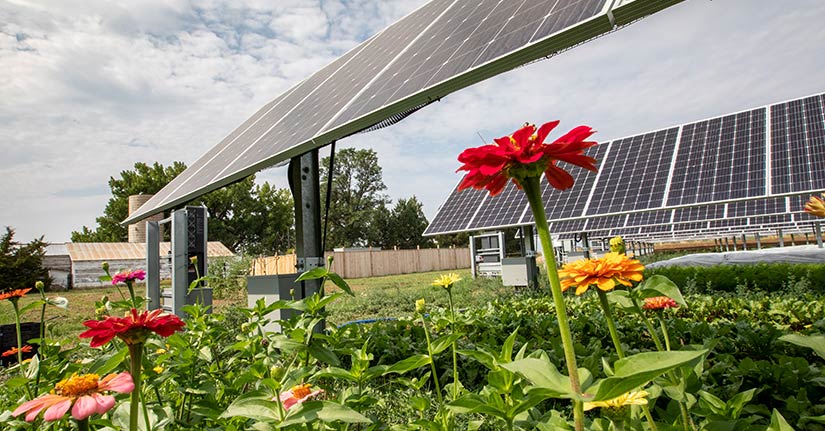Sharing the Sun Market Report Details Expansive Growth, Recent Trends in Community Solar
Co-Authors Share Findings on Policy Changes and Which States Are Leading Growth in Oct. 26 Webinar

Flowers grow along some of the rows at Jack's Solar Garden in Longmont, Colorado, to attract pollinators such as honeybees, bumblebees, and butterflies. Jack’s is a 1.2-MW, five-acre community solar farm and is the largest agrivoltaic research project in the U.S. The solar project was designed and built by Namasté Solar. Photo by Werner Slocum, NREL
More and more Americans are gaining access to clean energy through community solar. On Oct. 26 at 12 p.m., the authors of a new market report, Sharing the Sun: Community Solar Deployment, Subscription Savings, and Energy Burden Reduction, will discuss policy changes, recent market trends, subscriber value proposition, and how a handful of states are leading the charge when it comes to the tremendous growth seen in community solar projects over the past decade.
Community solar allows customers within a geographic area to benefit from solar energy, even if they are unable to install solar in their individual residences or businesses. Most often, community solar customers subscribe to an off-site array and then receive credits on their electric utility bill for a portion of the energy generated.
Community solar can be a great option for people who are unable to install solar panels on their roofs because they do not own their homes; have insufficient solar resources or roof conditions to support a rooftop PV system due to shading, roof size, or other factors; or face financial/other reasons.
Co-authored by researchers from the National Renewable Energy Laboratory and the University of Minnesota, the new report shows the tremendous growth of community solar over the past decade, which now consists of about 1,600 projects in the United States exceeding 3.2 gigawatts in capacity.
According to the report, cumulative community solar capacity has grown by about 121% year over year since 2010, more than doubling in capacity on average.
During the webinar, the authors will discuss the financial value that community solar
brings to its subscribers and the potential for community solar to reduce consumers’
energy burden. Community solar can lead to substantial bill savings—from 5% to as
much as 25%. According to the report, the bill savings from community solar can also
help reduce households' energy burden, or the share of gross household income spent
on energy costs such as electricity and heating fuel. In Washington, D.C., for example,
community solar subscriptions provided through the Solar for All program reduced energy
burdens for the lowest income households from 13.5% to 8.8%.
The webinar will also review the policy and deployment status of programs targeting
low- and moderate-income (LMI) subscribers.
The U.S. Department of Energy (DOE) recently announced a goal to expand community
solar to power the equivalent of 5 million households by 2025 and create $1 billion
in energy bill savings through the National Community Solar Partnership (NCSP). The
NCSP is a coalition of community solar stakeholders working to expand access to affordable
community solar to every American household. A key aspect of meeting the $1 billion
DOE target will be to ensure that those savings reach those who need them most.
The Sharing the Sun market report was funded by the NCSP, a DOE initiative led by the Solar Energy Technologies Office, in collaboration with NREL and the Lawrence Berkeley National Laboratory.
Learn more about the National Community Solar Partnership.
This article has been updated to reflect an editorial change made after its original publication.
Last Updated May 28, 2025
